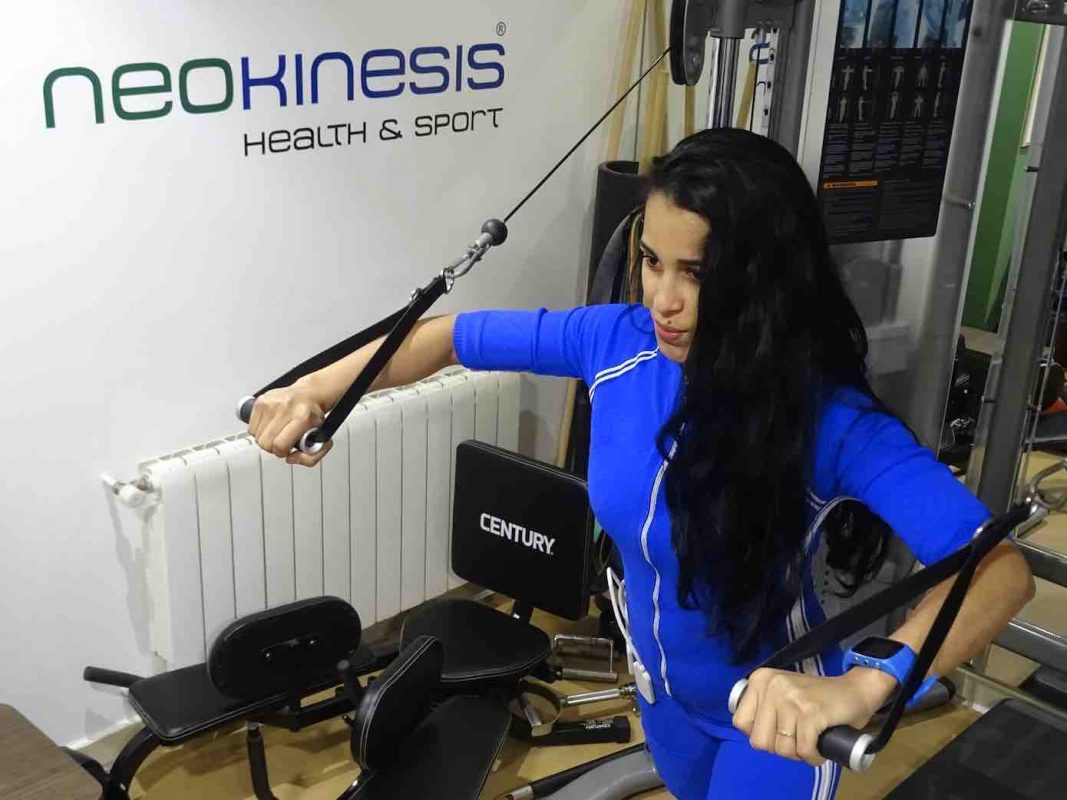Electrofitness suits, EMS Training, MUSCLE ELECTROSTIMULATION, PHYSICAL TRAINING
Strength training with electrofitness vests or suits
Strength training with electrofitness suits or vests, what factors should I take into account?
Training with EMS GLOBAL through suits or muscle electrostimulation vests has spread in recent years all over the world. But are the coaches applying it judiciously? Is there a real knowledge of how electrostimulation should be applied?
In this blog post we are going to focus on the application of the EMS GLOBAL to strength training, and we will try to offer this criterion that unfortunately, we think does not exist today, in a simple and practical way, and that this is not only a loss of prestige for the professional and the technology itself but still worse, it supposes that the client is not receiving a service according to their objectives and also, is exposing himself to a risk.

Strength training is, for many reasons, the most demanded worldwide by customers who come to sports centers. We all find familiar statements such as these:
- I would like to tone my body
- I would like to harden, I think I have flaccidity
- I would like to lift my butt and feel more beautiful
- I want to increase the volume of my arms and chest
- I need to gain strength to compete, …
Then the personal trainer who works with global muscle electrostimulation must have two main ideas clear:
-
Muscle electrostimulation has been shown to be effective in gaining strength and muscle mass.
-
Muscle electrostimulation is a complement to training and not a single system.
From now on, let’s talk about individualizing the training to our clients, and in order to do it in a practical and reproducible way, I will continue my writing as points:
WHAT ARE THE ELECTRICAL PARAMETERS TO DETERMINE FOR THE DIFFERENT OBJECTIVES?
INTENSITY (mA): once the proper progression of the training with the Myox EMS progression criteria has been made, and we are at the optimum point to demand the maximum from our client/athlete, we can administer the maximum tolerable energy taking into account the different “maximum assumptions “:
- isometric maximum: executions without movement
- dynamic maximum: the applied intensity must allow a complete joint range
- technical maximum: must allow quality technical executions, in no case the electrical impulse will be causing a technical deterioration.
We must also take into account two great customer profiles:
- The common user who wants to tone up: they don’t need, in any case, to be taken to tolerable maximums, although we can progressively increase our level of demand, it is not justified to reach these maximums.
- Professional athlete or demanding athlete: we will definitely need to reach these levels of maximum demand, obviously, with proper planning.

CRONAXIA (us): minimum impulse time to produce depolarization of the motor nerve and as a consequence, muscle contraction. Also technically known as “pulse width” as it corresponds to the width (duration) of the rectangular electric wave. Ideally, we should be able to respect the chronaxies for the respective muscular areas:
- FOREARM: 150 us
- ARM: 200 us
- TORAX: 250 us
- ABDOMEN: 300 us
- THIGH AND GLUTEUS: 350 us
- LEG: 400 us
For the brands of electrostimulation suits that don’t allow the customization of the chronaxie by areas we recommend:
- Start with cronaxias of 150 to 200 us in the first sessions
- Increase progressively, keeping in mind that a greater chronaxia also means greater motor recruitment.
- The maximum strength levels will be between 300 and 350 us.
FREQUENCY (Hz): number of pulses per second, this is the main electrical parameter and determines the objective. Regarding the specific issue that concerns us in this article we specify the following data:
- Muscle tone gain: 45 to 55 Hz, maximum 60 Hz
- Muscle mass gain: 70 to 75 Hz
- Resistance strength gain: 60 to 70 Hz
- Maximum force gain: 80 to 100 Hz
- Power gain: 100 to 120 Hz
- Power gain in professionals: up to 150 Hz
RAMP: the time that it takes from the start of the impulse until reaching its maximum intensity. At Myox we recommend working sensibly, as the ramps are one of the simplest parameters and at the same time one of the most misunderstood and worse used in the global electrostimulation market. At Myox we defend that the ideal training is the sum of PRECISION + SECURITY + DEMAND.
And this means, let’s program to reach our goal, and the greater comfort we achieve, the better! And, of course, if our goal is related to sports and the demand for results is a sacrifice of comfort, then it must be assumed. We propose the following in relation to the ramps:
- muscle tone gain in non-professional individuals: 1.5 s of ramp (1.2 of ramp down)
- strength resistance gain or hypertrophy: 1.2 ramp up (0.8 ramp down)
- maximum force gain: 0.8 ramp up (0.6 ramp down)
- power: 0.4 or 0.5 ramp
- power in professionals (boxing, jumping, …): 0 s of ramp, we eliminate it.
- Note 1: the ramp down is the time that the intensity takes to fall to zero, and is usually somewhat less than the ramp up. A contraction is the sum of RAMP UP + MAINTENANCE OF THE IMPULSE + RAMP DOWN.
- Note 2: Everything described in this article corresponds to Myox advanced training protocols.

IS MY OBJECTIVE GLOBAL OR SPECIFIC?
Okay, I consider myself a personal trainer specialized in electric muscle stimulation, so as a matter of fact, I must attend to my main function: “personalize the training with muscle electrostimulation”. Well, from Myox EMS we are going to help you with this effect:
Studies have shown that gain of strength with electric muscle stimulation is significantly higher when training is performed locally or analytically, compared to a global stimulus of a large muscle mass. Therefore, from the Myox EMS methodology, we teach our students to understand the electrostimulation suit not as “a unit or a whole” but as the sum of many units, that is, the sum of 8, 10 or 12 circuits. This way of understanding a muscular electrostimulation vest supposes that the professional will have the capacity to make a large amount and of high-quality decisions.
But, why are we telling you all this? Because when we meet a client whose intention is to strengthen and lift his/her buttocks, what we should do is focus the impulse in this area, therefore we recommend connecting only the circuit that stimulates this muscle group. The same happens when an athlete wants to perform a workout for maximum hypertrophy in their biceps. Focusing on a single muscle group in light of these challenges, allows us to apply the best technique possible, control the times and rhythms, and of course, the amount of intensity tolerated locally will be greater than if the stimulus was global, and as I said before, it will allow us to achieve the greatest benefits.
On the other hand, if due to time, objectives, ambitions or real needs, the purpose is the gain of strength or general tone, we can work with all the equipment connected. Even so, from Myox we recommend applying progression criteria according to the number of muscles involved.
WHAT EXERCISES CAN I APPLY?
Well, this is a very extensive topic to talk about, so I proceed to give concrete and practical answers, and for more information, I advise you to read more articles of our muscle electrostimulation blog.
I would like to highlight these entries:
- TALK ABOUT HYPOTROPHY WITH ELECTRIC MUSCLE STIMULATION
- APPLICATION OF EXTERNAL LOADS IN TRAINING WITH MUSCLE ELECTROSTIMULATION
- PROGRESSION IN MUSCLE TRAINING + ELECTROSTIMULATION
- ELECTRICAL PARAMETERS FOR HYPERTROPHY TRAINING
Having recommended these readings, we comment:
- Analytical exercises, normally monoarticular, when the decision to perform strength training in a specific area has been made, where all the technical and effort demands will be concentrated.
- It should be noted at this point that regarding global, multi-articular exercises such as “squats”, electrostimulation may be the one that causes the maximum involvement of one of the muscles involved in the mentioned gesture.
- Global exercises when electric muscle stimulation is applied globally, that is, the entire suit is connected.
I would like to point out that one of the most important aspects developed in our Myox formations is the one that refers to the progression, demand, and individualization in relation to the combination of the electrical impulse with isometric actions, dynamic-concentric or dynamic-eccentric. Stay tuned to our blog, talks, and training and we will provide you with privileged information.
I hope that this article has helped and inspired you. My name is Juan Peris, a specialist in electrostimulation for almost 20 years; I am and I will be at your disposal to spread your doubts. You can reflect your comments on this blog below or participate in our forums.
Sports Sciences DEA
Physical Trainer – Col. 12.739
Physiotherapist – Col. 3.319
Myox Specialist in Muscle Electrostimulation

